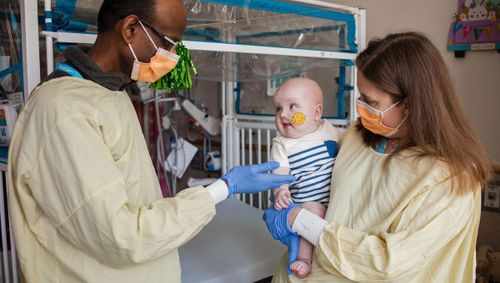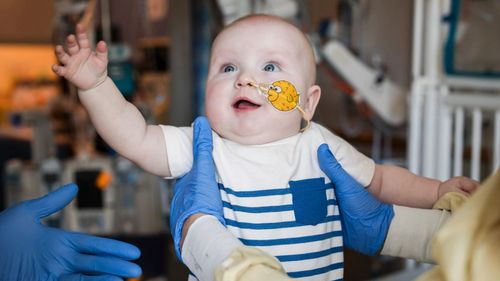Groundbreaking Gene Editing Treatment Helps Baby With Life-Threatening CPS1 Deficiency
Articles
Summary

Child treated with gene editing therapy for the first time by a team of Philadelphia doctors
A child diagnosed with a rare genetic disorder was successfully treated with a customized CRISPR gene editing therapy by a team at Children's Hospital of Philadelphia and Penn Medicine in a historical medical breakthrough. The landmark study published in The New England Journal of Medicine showcases the power of customized gene editing therapy to treat patients with rare metabolic disease. Nine-month-old KJ Muldoon was the first patient to be treated with a gene editing technology customized for his rare disease.
Left
CBS News
Gene-editing therapy made in just 6 months helps baby with life-threatening disease
In a world first, researchers report easing the symptoms of a baby boy with a rare, life-threatening disease by giving him a version of the CRISPR gene editor tailored to a mutation he carries. The boy, first treated in February at just 7 months old, still needs a special diet and medication; the experimental therapy alone isn’t enough to prevent a dangerous buildup of ammonia in his blood caused by a faulty gene for a key liver enzyme. Still, the swift development of a gene editor that appears to have repaired the defect in some of his liver cells is a landmark demonstration of a personalized approach that has tantalized rare disease researchers.
Middle
AAAS
Infant Becomes First Human Ever To Receive Personalized CRISPR Gene Therapy Treatment
n infant with a life-threatening and incurable genetic disease has become the first human to successfully receive a personalized gene editing therapy. This is a massive achievement and could represent a platform for the rapid development of treatments for other genetic diseases. The child was diagnosed with carbamoyl phosphate synthetase 1 (CPS1) deficiency shortly after birth. This condition is characterized by an inability to fully break down protein byproducts in the liver.
Right
IFLScience
World first as baby KJ has ‘DNA rewritten’ to wipe deadly genetic disorder
KJ Muldoon, now 15 months old, was diagnosed with an ultra rare disease just days after his birth. It impaired his liver’s ability to process ammonia, which can build up and cause permanent brain damage or death. The disease its estimated to affect one in 800,000 to one in 1,300,000 births.
Right
The Sun
Breakthrough Gene Therapy Saves Infant with Rare Metabolic Disease
An infant born with a lethal metabolic disorder was cured with a groundbreaking approach that involved a personalized gene-editing therapy. The technology used creates an opportunity for the development of personalized treatments for other rare diseases. The medical breakthrough was described in a new study published in The New England Journal of Medicine.
Middle
Managed Healthcare ExecutiveArticles
Summary
SCIENCE/TECHNOLOGY
US Targets Russian Cybercriminals: Key Figure Rustam Gallyamov Indicted for Leading Qakbot Ransomware Operation
Updated: 6 hours ago
Articles
Summary
SCIENCE/TECHNOLOGY
Elon Musk’s AI Chatbot Grok Sparks Outrage Over Holocaust Denial
Updated: 5 days ago
Articles
Summary
SCIENCE/TECHNOLOGY
Musk's xAI Says 'Unauthorized Modification' Led Grok to Discuss 'White Genocide' in Response to Unrelated Subjects
Updated: 8 days ago
Articles
Summary
SCIENCE/TECHNOLOGY
Crypto Exchange Coinbase Says Hackers Stole Sensitive User Data, Prompting Shares to Drop
Updated: 9 days ago
Articles
Summary






































